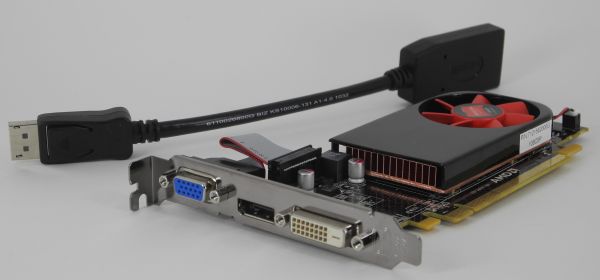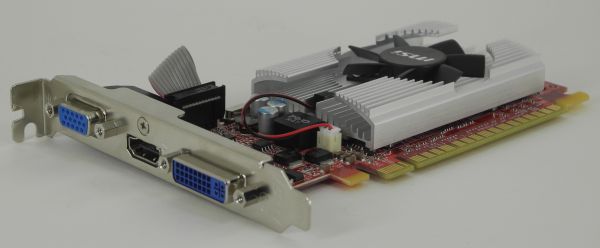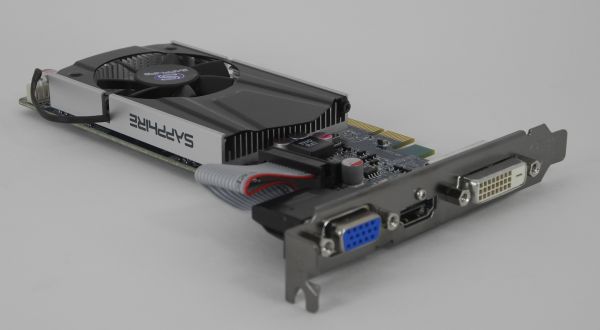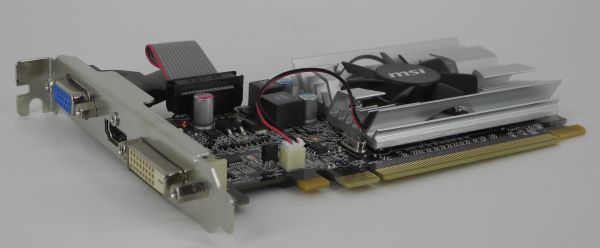Discrete HTPC GPU Shootout
by Ganesh T S on June 12, 2011 10:30 PM ESTOur first candidate has been in our labs for more than 6 months now. When we last took a look at the NVIDIA GT 430, it was an underwhelming performer. Have driver updates fixed the issues we had with the card? We are going to put the NVIDIA reference card through the paces and also through our new benchmarking methodology.
From the AMD side, we have 6450 reference card. This is the same card that Ryan took a look at earlier. We didn't cover too many HTPC specific issues in that review (except noting that the deinterlacing performance matched that of the 5570's), and we will correct that aspect in this piece.
AMD also provided us with a Display Port to HDMI adapter so that we could test out HD audio bitstreaming, and it worked without issues.
The second NVIDIA card we have in the list is the recently introduced GT 520. Ryan had again covered the launch, but without a detailed review. NVIDIA provided us with a retail sample of the MSI N520GT.
Rounding up our initial set of candidates is the AMD 6570 retail sample, courtesy Sapphire.
NVIDIA let us know that the GDDR5 based 6450 from AMD was not representative of what is available in the market. There is no passively cooled GDDR5 based 6450, and the core clocks of all the 6450s in the market weigh in at 625 MHz (compared to the reference card's 750 MHz). Keeping this in mind, we also added a DDR3 based MSI 6450 (quite late in the game) to the list of contenders.
The table below compares the listed specifications of all the contenders.
| Discrete HTPC GPUs Shootout Contenders | |||||
| NVIDIA GT 430 | AMD 6450 [GDDR5] | MSI GT 520 | Sapphire 6570 [DDR3] | MSI 6450 [DDR3] | |
| AMD Stream Processors | 160 | 480 | 160 | ||
| NVIDIA Stream Processors | 96 | 48 | |||
| Core Clock (MHz) | 700 | 750 | 810 | 650 | 625 |
| Shader Clock (MHz) | 1400 | 1620 | |||
| Memory Clock (Data Rate) (MHz) | 900 (1800) | 900 (3600) | 900 (1800) | 900 (1800) | 667 (1333) |
| DRAM Configuration | 128b 1GB DDR3 | 64b 512MB GDDR5 | 64b 1GB DDR3 | 128b 1GB DDR3 | 64b 1GB DDR3 |
| Max. TDP (W) | 49 | 27 | 29 | 44 | 20 |
Let us now proceed to take a look at the HTPC testbed in which these cards were benchmarked.















70 Comments
View All Comments
enki - Monday, June 13, 2011 - link
How about a short conclusion section for those who just use a Windows 7 box with a Ceton tuner card to watch hdtv in Windows Media Center? (i.e. will just be playing back WTV files recorded directly on the box)What provides the best quality output?
What can stream better then stereo over HDMI? On my old 3400 ATI card it either streams the Dolby Digital directly (the computer doesn't do any processing of the audio) or can output stereo (doesn't think there can be more then 2 speakers connected)
Thanks
BernardP - Monday, June 13, 2011 - link
The inability to create and scale custom resolutions within AMD graphics drivers is, for me, a deal-breaker that keeps me from even considering AMD graphics. It will also keep me from Llano, Trinity and future AMD Fusion APU's. I'll stay with NVidia as long as they keep allowing for custom resolutions.My older eyes are grateful for the custom 1536 X 960 desktop resolution on my 24 inch 16:10 monitor. I couldn't create this resolution with AMD graphics drivers.
bobbozzo - Tuesday, June 14, 2011 - link
In your case, you should just increase the size of the fonts and widgets instead of lowering the screen res.Assimilator87 - Tuesday, June 14, 2011 - link
I wish there was a section dedicated to the silent stream bug. I have a GTX 470 hooked up to an Onkyo TX-SR805 and this issue is driving me insane. For instance, does this issue only plague certain cards or do all nVidia suffer from it? I was hoping the latest WHQL driver (275.33) would fix this, but sadly, no. Otherwise, the article was amazing and I'll definitely have to check out LAV Splitter.ganeshts - Tuesday, June 14, 2011 - link
The problem with the silent stream bug is that one driver version has it, the next one doesn't and then the next release brings it back. It is hard to pinpoint where the issue is.Amongst our candidates, even with the same driver release, the GT 520 had the bug, but the GT 430 didn't. I am quite confident that the GT 520 issue will get resolved in a future update, but then, I can just hope that it doesn't break the GT 430.
JoeHH - Tuesday, June 14, 2011 - link
This is simply one of the best articles I have ever seen about HTPC. Congrats Ganesh and thank you. Very informative and useful.bobbozzo - Tuesday, June 14, 2011 - link
Hi, Can you please compare hardware de-intelacing, etc., vs software?e.g. many players/codecs can do de-interlacing, de-noise, etc. in software, using the CPU.
How does this compare with a hardware implementation?
thanks
ganeshts - Tuesday, June 14, 2011 - link
This is a good suggestion. Let me try that out in the next HTPC / GPU piece.CiNcH - Wednesday, June 15, 2011 - link
Hey guys,here is how I understand the refresh rate issue. It does not matter weather it is 0.005 Hz off. You can't calculate frame drops/repeats from that. In DirectShow, frames are scheduled with the graph reference clock. So the real problem is how much the clock which the VSync is based on and the reference clock in the DirectShow graph drift from each other. And here comes ReClock into play. It derives the DirectShow graph clock from the VSync, i.e. synchronizes the two. So it does not matter weather your VSync is off as long as playback speed is adjusted accordingly. A problem here is synchronizing audio which is not too easy if you bitstream it...
NikosD - Thursday, June 16, 2011 - link
Nice guide but you missed something.It's called PotPlayer, it's free and has built-in almost everything.
CPU & DXVA (partial, full) codecs and splitters for almost every container and every video file out there.
The same is true for audio, too.
It has even Pass through (S/PDIF, HDMI) for AC3/TrueHD/DTS, DTS-HD. Only EAC3 is not working.
It has also support for madVR and a unique DXVA-renderless mode which combines DXVA & madVR!
I think it's close to perfect!
BTW, in the article says that there is no free audio decoder for DTS, DTS-HD.
That's not correct.
FFDShow is capable of decoding and pass through (S/PDIF, HDMI) both DTS and DTS-HD.
And PotPlayer of course!